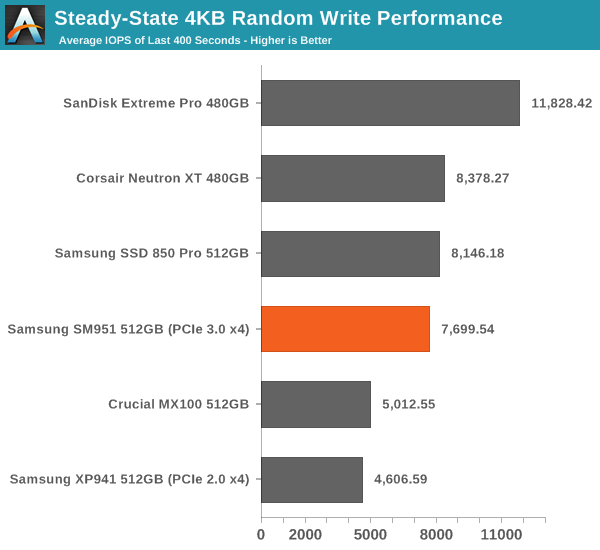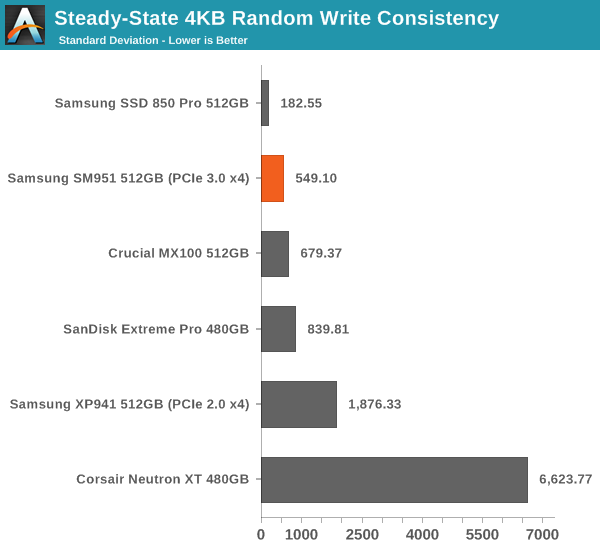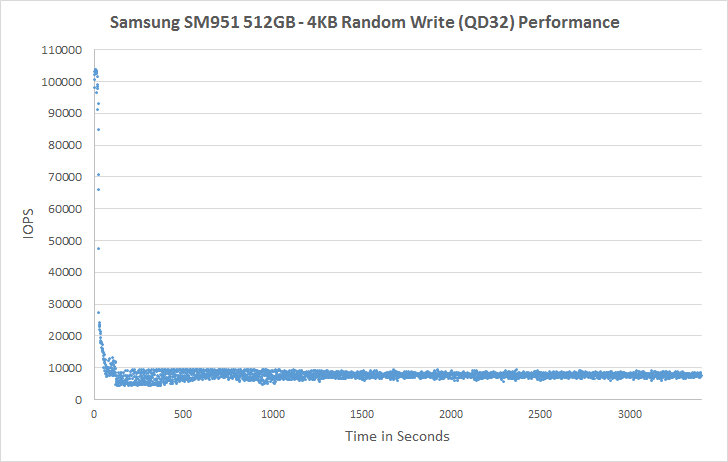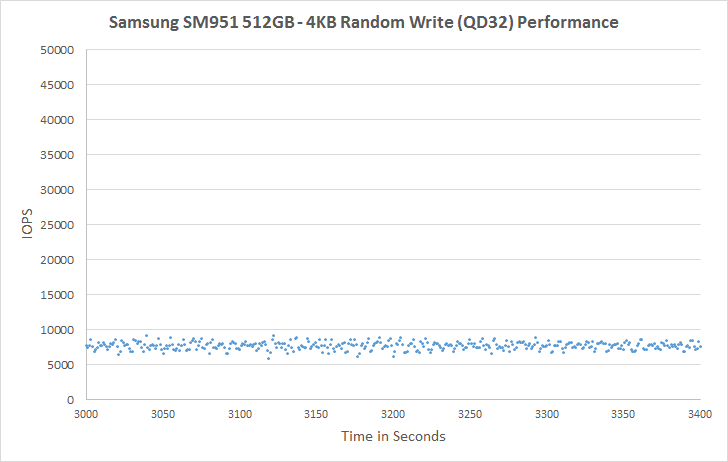Samsung SM951 (512GB) PCIe SSD Review
by Kristian Vättö on February 24, 2015 8:00 AM ESTPerformance Consistency
We've been looking at performance consistency since the Intel SSD DC S3700 review in late 2012 and it has become one of the cornerstones of our SSD reviews. Back in the days many SSD vendors were only focusing on high peak performance, which unfortunately came at the cost of sustained performance. In other words, the drives would push high IOPS in certain synthetic scenarios to provide nice marketing numbers, but as soon as you pushed the drive for more than a few minutes you could easily run into hiccups caused by poor performance consistency.
Once we started exploring IO consistency, nearly all SSD manufacturers made a move to improve consistency and for the 2015 suite, I haven't made any significant changes to the methodology we use to test IO consistency. The biggest change is the move from VDBench to Iometer 1.1.0 as the benchmarking software and I've also extended the test from 2000 seconds to a full hour to ensure that all drives hit steady-state during the test.
For better readability, I now provide bar graphs with the first one being an average IOPS of the last 400 seconds and the second graph displaying the standard deviation during the same period. Average IOPS provides a quick look into overall performance, but it can easily hide bad consistency, so looking at standard deviation is necessary for a complete look into consistency.
I'm still providing the same scatter graphs too, of course. However, I decided to dump the logarithmic graphs and go linear-only since logarithmic graphs aren't as accurate and can be hard to interpret for those who aren't familiar with them. I provide two graphs: one that includes the whole duration of the test and another that focuses on the last 400 seconds of the test to get a better scope into steady-state performance.

In steady-state performance the SM951 provides a substantial ~70% upgrade over the XP941 and brings performance nearly to the same level with the 850 Pro. Given that the 850 Pro uses faster V-NAND, the steady-state performance is a pleasant surprise and shows that the SM951 is more than a marginal bump from the XP941. Obviously, drives with more default over-provisioning (i.e. Extreme Pro and Neutron XT) provide higher steady-state performance, but Samsung is doing very well with the default 7% over-provisioning.

The consistency of the SM951 is also great. The Neutron XT is a living proof of a drive with high average IOPS, but horrible consistency because as we can see in the graph above its standard deviation is up to dozens of times higher compared to the other drives. That's just not acceptable for a modern drive, especially because there are many drives that can consistently provide high IOPS.
 |
|||||||||
| Default | |||||||||
| 25% Over-Provisioning | |||||||||
For a dozen seconds or so, the SM951 is actually able to burst out 100K IOPS, but the performance soon drops to below 10K IOPS and eventually evens out at ~7.5K IOPS. The SM951 is very consistent and doesn't experience any notable IOPS drops, whereas the XP941 regularly drops to a few hundred IOs per second. Increasing the over-provisioning to 25% brings the IOPS to about 35K, which is very decent and again much better than the XP941 that still has odd drops in performance.
 |
|||||||||
| Default | |||||||||
| 25% Over-Provisioning | |||||||||










128 Comments
View All Comments
Kevin G - Tuesday, February 24, 2015 - link
"I also verified that the SM951 is bootable in tower Mac Pros (2012 and earlier)."Excellent. The old 2010/2012 towers continue to show that being expandable provides long term benefit. I'm glad that I picked up my tower Mac Pro when I did.
Now to find a carrier that'll convert the 4x PCIe 3.0 link of the M.2 connector to an 8x PCIe 2.0 link for a Mac Pro. (Two two M.2s to a single 16x PCIe 2.0 link.)
extide - Tuesday, February 24, 2015 - link
You will need a PLX chip to do that, you can't just put 2 x4 devices into an x8 slot...jimjamjamie - Wednesday, February 25, 2015 - link
It's pretty hilarious how many people drink the shiny plastic trash bin kool-aid.Tunnah - Tuesday, February 24, 2015 - link
I'm not super knowledgeable on the whole thing, but isn't NVMe really only a big deal for enterprise, as it's more a benefit for multi drive setups ?Kristian Vättö - Tuesday, February 24, 2015 - link
It's of course a bigger deal for enterprises because the need for performance is higher. However, NVMe isn't just a buzzword for the client space because it reduced the protocol latency, which in turn results in higher performance at low queue depths that are common for client workloads.knweiss - Sunday, March 1, 2015 - link
Kristian, did you ever test how much influence the filesystem has? I would love to see a filesystem comparison on the various platforms with NVMe drivers (Windows, Linux, FreeBSD, etc).The_Assimilator - Tuesday, February 24, 2015 - link
Hopefully NVMe will be standard on SSDs by the time Skylake and 100-series chipsets arrive.sna1970 - Tuesday, February 24, 2015 - link
What is the point of this expensive drive when you can have the same numbers using 2 SSD in Raid 0 ?and please no one says to me risk of Data Loss .. SSD are not mechanical and the chance of loosing 1 SSD is the same of 2 of them.
Kristian Vättö - Tuesday, February 24, 2015 - link
RAID only tends to increase high QD and large IO transfers where the IO load can easily be distributed between two or more drives. Low QD performance at small IO sizes can actually be worse due to additional overhead from the RAID drivers.dzezik - Tuesday, February 24, 2015 - link
Hi sna1970. You misses Bernouli's "introduced the principle of the maximum product of the probabilities of a system of concurrent errors" it is quite old 1782 but is is still valid. Have You ever been in school. Do You have mathematics classes?